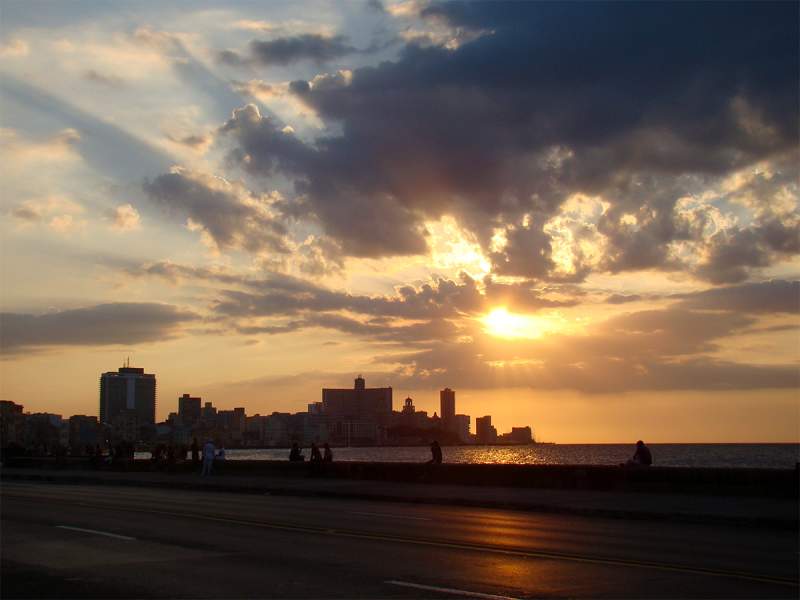‘Sapphires, blue madness’ (Zafiros, locura azul) was a completely exceptional case in the Cuban cinema of ICAIC. Produced from the United States, by Hugo Cancio, with script co-written by Raúl Macías and former Zafiro Miguel Cancio, and with music by Juan Antonio Leyva and Magda Rosa Galván (daughter of Manuel Galván, artistic director of Los Zafiros for many years) Represented an act of justice for the thousands, millions of Cubans who remembered with fondness the famous quartet.
A single film set the whole country to sing songs that seemed forgotten, and the Cubans of the Special Period in 1997 and 1998 discovered the relief of nostalgia.
In the International Festival of New Latin American Cinema corresponding to December 1997, Zafiros, blue madness had been released, and suddenly, without too much processing, became the most popular film of an event where they were awarded such valuable and popular films as The Argentines Martin (Hache) and Cenizas of paradise, the Cuban Kleines Tropikana and the Brazilian A sky of stars.
The actors were rewarded by the great histriones when they dare to reinterpret a myth, and they do it from the respect and the professionalism, because the Sapphires inhabited in that space of the collective memory where they retire only the legendary, mythical artists , And so Luis Alberto García, Néstor Jiménez, Bárbaro Marín and Sirio Soto understood it, ready to put face and soul to the creators who managed to renew the Cuban music assuming, without complexes, the foreign influences. To the group of authors, Juan Antonio Leyva, in charge of the role of Galván, was added.
Twenty years later, I can write the same thing I published in March 1998, when it was still being shown in Havana and I wrote in Juventud Rebelde: “That unique copy of Zafiros, blue madness, exhibited in a single capital cinema, may be remembered by A long time as a cultural and sociological event, a revealing attempt, albeit sporadically, of a national cinema that wants to be deeply popular. Reminiscent of past times, the film has become a clear celebration of the music that has kept us together, and identifiable, as a nation. ”
Sapphires, blue madness is a bit chronically feigned, and so much effective narrative, of that event that in its time marked the famous quartet, whose mythology and legend feeds from all possible edges, especially from the writers’ To remember the birth of the myth, its first and great steps.
“Zafiros, locura azul” un recuerdo inolvidable.
Zafiros, locura azul fue un caso completamente excepcional en el cine cubano del ICAIC. Producida desde Estados Unidos, por Hugo Cancio, con guión coescrito por Raúl Macías y el ex Zafiro Miguel Cancio, y con música de Juan Antonio Leyva y Magda Rosa Galván (hija de Manuel Galván, director artístico de Los Zafiros durante muchos años) el filme representaba un acto de justicia para los miles, millones de cubanos que recordaban con cariño al célebre cuarteto.
Una sola película puso a cantar a todo un país al son de canciones que parecían olvidadas, y los cubanos del Periodo Especial, en 1997 y 1998, descubrieron el alivio de la nostalgia.
En el Festival Internacional del Nuevo Cine Latinoamericano correspondiente a diciembre de 1997 se había estrenado Zafiros, locura azul, y de súbito, sin demasiado trámite, se convirtió en el filme más popular de un evento donde fueron premiados filmes tan valiosos, y populares, como los argentinos Martín (Hache) y Cenizas del paraíso, el cubano Kleines Tropikana y el brasileño Un cielo de estrellas.
A los actores les tocó la recompensa que reciben los grandes histriones cuando se atreven a reinterpretar un mito, y lo hacen desde el respeto y la profesionalidad, porque los Zafiros habitaban en ese espacio de la memoria colectiva donde se aposentan solo los artistas legendarios, míticos, y así lo entendieron Luis Alberto García , Néstor Jiménez , Bárbaro Marín y Sirio Soto, dispuestos a ponerle rostro y alma a los creadores que consiguieron renovar la música cubana asumiendo, sin complejos, las influencias foráneas. Al grupo de autores, se añadió Juan Antonio Leyva, encargado del papel de Galván.
Veinte años después, puedo escribir lo mismo que publiqué en marzo de 1998, cuando todavía se exhibía en La Habana y escribí en Juventud Rebelde: “Esa copia única de Zafiros, locura azul, exhibida en un único cine capitalino, tal vez sea recordada por largo tiempo como suceso cultural y sociológico, tentativa reveladora, si bien esporádica, de un cine nacional que se quiere hondamente popular. Reminiscente de pasados tiempos, la película ha devenido nítida celebración de la música que nos ha mantenido juntos, e identificables, como nación”.
Zafiros, locura azul es un poco crónica festinada, y otro tanto relato efectivo, de ese suceso que en su tiempo marcó el famoso cuarteto, cuya mitología y leyenda se alimenta desde todas las aristas posibles, sobre todo a partir del empeño de los guionistas por rememorar el nacimiento del mito, sus primeros y grandes pasos.
Agencies/Cibercuba/Joel del Río/Extractos/Internet Photos/ YouTube/ Arnoldo Varona/ TheCubanHistory.com
THE CUBAN HISTORY, HOLLYWOOD.





